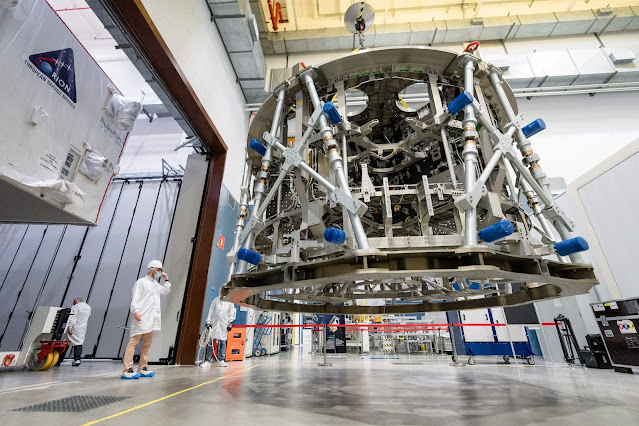NASA's Mars Curiosity & Perseverance Rovers—New May 2022 Images | JPL
Mars2020 - Sol 452 - Watson
NASA/JPL-Caltech/Kevin M. Gill
V2.png)
Mars2020 - Sol 451 - Mastcam-Z
NASA/JPL-Caltech/ASU/Kevin M. Gill
MSL - Sol 3485 - Mastcam
NASA/JPL-Caltech/MSSS/Kevin M. Gill
Mars2020 - Sol 448 - Mastcam-Z
NASA/JPL-Caltech/ASU/Kevin M. Gill
MSL - Sol 3485 - Mastcam
NASA/JPL-Caltech/MSSS/Kevin M. Gill
MSL - Sol 3483 - Mastcam
NASA/JPL-Caltech/MSSS/Kevin M. Gill
MSL - Sol 3481 - Mastcam
NASA/JPL-Caltech/MSSS/Kevin M. Gill
Curiosity Rover Update:
"Our intrepid rover engineers again successfully navigated Curiosity a little higher up Mount Sharp (~5 m) and ~40 m on the ground, away from our previous location. The terrain beneath the rover included striated, dusty bedrock and sand ripples with coarse lag deposits."
"The environmental scientists planned several observations to continue monitoring changes in atmospheric conditions and the current dust storm within Gale crater. These included: Navcam line of sight images, a large dust devil survey, suprahorizon movies, a dust devil movie, and a zenith movie; and Mastcam basic and full tau observations."
Caption Credit: Lucy Thompson, Planetary Geologist, University of New Brunswick
Release Date: May 26, 2022
Perseverance Rover Update:
Since NASA's Perseverance rover landed on Mars, its two microphones have recorded hours of audio that provide valuable information about the Martian atmosphere.
After more than a year of recording on the surface, the team reduced the data to a Martian playlist that features about five hours of sounds. Most of the time, Mars is very quiet. Sounds are 20 decibels lower than on Earth for the same source, and there are few natural noises except for the wind.
"It is so quiet that, at some point, we thought the microphone was broken!" said Chide.
However, after listening carefully to the data, the group uncovered fascinating phenomena. There was a lot of variability in the wind, and the atmosphere could abruptly change from calm to intense with rapid gusts. By listening to well-characterized and intentional laser sparks, Perseverance calculated the dispersion of the sound speed, confirming a theory that high-frequency sounds travel faster than those at low frequencies.
"Mars is the only place in the solar system where that happens in the audible bandwidth because of the unique properties of the carbon dioxide molecule that composes the atmosphere," said Chide.
The red planet's seasons impact its soundscape. As carbon dioxide freezes in the polar caps during winter, the density of the atmosphere changes and the environment loudness varies by about 20%. That molecule also attenuates high-pitched sounds with distance.
Source: Baptiste Chide of Los Alamos National Lab/Mars Daily
Release Date: May 26, 2022
Mission Name: Mars 2020
Rover Name: Perseverance
Main Job: Seek signs of ancient life and collect samples of rock and regolith (broken rock and soil) for possible return to Earth.
Launch: July 30, 2020
Landing: Feb. 18, 2021, Jezero Crater, Mars
Mission Name: Mars Science Laboratory (MSL)
Rover Name: Curiosity
Main Job: To determine if Mars was ever habitable to microbial life.
Launch: November 6, 2011
Landing: August 5, 2012, Gale Crater, Mars
For more information on NASA's Mars missions, visit mars.nasa.gov
Image Credit: NASA/JPL-Caltech/ASU/Kevin M. Gill
Image Release Dates: May 25-29, 2022
#NASA #Space #Astronomy #Science #Mars #RedPlanet #Planet #Astrobiology #Geology #Jezero #Crater #MountSharp #GaleCrater #Perseverance #Curiosity #Rovers #Ingenuity #Helicopter #Robotics #Technology #Engineering #JPL #Pasadena #California #UnitedStates #JourneyToMars #STEM #Education
.jpg)
V1.jpg)
.png)
JSC-Exp67-V1.jpg)
JSCExp67-V2.jpg)












.jpg)
.jpg)
.jpg)
.jpg)
V2.jpg)
.jpg)

.jpg)
.jpg)




V1.jpg)
V2.png)
V3.jpg)
V4.png)
V5.jpg)
V6.jpg)
V7.jpg)